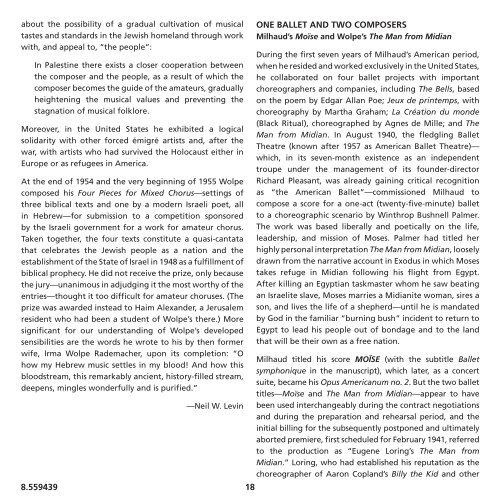Download Liner Notes PDF - Milken Archive of Jewish Music
Download Liner Notes PDF - Milken Archive of Jewish Music
Download Liner Notes PDF - Milken Archive of Jewish Music
You also want an ePaper? Increase the reach of your titles
YUMPU automatically turns print PDFs into web optimized ePapers that Google loves.
about the possibility <strong>of</strong> a gradual cultivation <strong>of</strong> musicaltastes and standards in the <strong>Jewish</strong> homeland through workwith, and appeal to, “the people”:In Palestine there exists a closer cooperation betweenthe composer and the people, as a result <strong>of</strong> which thecomposer becomes the guide <strong>of</strong> the amateurs, graduallyheightening the musical values and preventing thestagnation <strong>of</strong> musical folklore.Moreover, in the United States he exhibited a logicalsolidarity with other forced émigré artists and, after thewar, with artists who had survived the Holocaust either inEurope or as refugees in America.At the end <strong>of</strong> 1954 and the very beginning <strong>of</strong> 1955 Wolpecomposed his Four Pieces for Mixed Chorus—settings <strong>of</strong>three biblical texts and one by a modern Israeli poet, allin Hebrew—for submission to a competition sponsoredby the Israeli government for a work for amateur chorus.Taken together, the four texts constitute a quasi-cantatathat celebrates the <strong>Jewish</strong> people as a nation and theestablishment <strong>of</strong> the State <strong>of</strong> Israel in 1948 as a fulfillment <strong>of</strong>biblical prophecy. He did not receive the prize, only becausethe jury—unanimous in adjudging it the most worthy <strong>of</strong> theentries—thought it too difficult for amateur choruses. (Theprize was awarded instead to Haim Alexander, a Jerusalemresident who had been a student <strong>of</strong> Wolpe’s there.) Moresignificant for our understanding <strong>of</strong> Wolpe’s developedsensibilities are the words he wrote to his by then formerwife, Irma Wolpe Rademacher, upon its completion: “Ohow my Hebrew music settles in my blood! And how thisbloodstream, this remarkably ancient, history-filled stream,deepens, mingles wonderfully and is purified.”—Neil W. Levin8.559439 18ONE BALLET AND TWO COMPOSERSMilhaud’s Moïse and Wolpe’s The Man from MidianDuring the first seven years <strong>of</strong> Milhaud’s American period,when he resided and worked exclusively in the United States,he collaborated on four ballet projects with importantchoreographers and companies, including The Bells, basedon the poem by Edgar Allan Poe; Jeux de printemps, withchoreography by Martha Graham; La Création du monde(Black Ritual), choreographed by Agnes de Mille; and TheMan from Midian. In August 1940, the fledgling BalletTheatre (known after 1957 as American Ballet Theatre)—which, in its seven-month existence as an independenttroupe under the management <strong>of</strong> its founder-directorRichard Pleasant, was already gaining critical recognitionas “the American Ballet”—commissioned Milhaud tocompose a score for a one-act (twenty-five-minute) balletto a choreographic scenario by Winthrop Bushnell Palmer.The work was based liberally and poetically on the life,leadership, and mission <strong>of</strong> Moses. Palmer had titled herhighly personal interpretation The Man from Midian, looselydrawn from the narrative account in Exodus in which Mosestakes refuge in Midian following his flight from Egypt.After killing an Egyptian taskmaster whom he saw beatingan Israelite slave, Moses marries a Midianite woman, sires ason, and lives the life <strong>of</strong> a shepherd—until he is mandatedby God in the familiar “burning bush” incident to return toEgypt to lead his people out <strong>of</strong> bondage and to the landthat will be their own as a free nation.Milhaud titled his score MOÏSE (with the subtitle Balletsymphonique in the manuscript), which later, as a concertsuite, became his Opus Americanum no. 2. But the two ballettitles—Moïse and The Man from Midian—appear to havebeen used interchangeably during the contract negotiationsand during the preparation and rehearsal period, and theinitial billing for the subsequently postponed and ultimatelyaborted premiere, first scheduled for February 1941, referredto the production as “Eugene Loring’s The Man fromMidian.” Loring, who had established his reputation as thechoreographer <strong>of</strong> Aaron Copland’s Billy the Kid and other
















